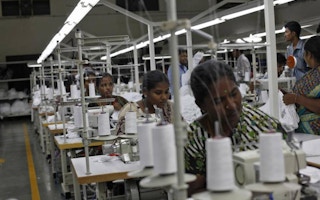The agenda was to improve the conditions for tens of thousands of India’s women garment workers who stitch everything from jeans to jackets for the world’s leading fashion brands.
But the strategy was flawed, say critics.
The Ethical Trading Initiative (ETI) aimed to gain access to often highly restricted factories in the southern textile centre of Tamil Nadu with a “hygiene awareness” programme and use that as a platform for promoting workers’ rights.
Five years and 485,000 pounds ($630,000) later, the ETI, which brings together labels like H&M, GAP and Burberry with unions, factory owners and civil society groups, has done little more than teach workers hand washing, campaigners say.
“
If they were more transparent about their supply chains, it would make it possible for global advocacy organisations to increase public pressure on companies to take action to ensure respect for labour rights.
Tim Connor, lecturer, Newcastle Law School
Trade unions and labour rights charities, some of them partners in the initiative, say its shortcomings show big stores are merely paying lip service to the rights of garment workers.
“It is like image management. Brands are using the ETI platform to safeguard themselves,” said Nambi Chelliah of non-profit group the Centre for Social Education and Development that was part of the ETI’s initial meetings.
Workers’ representatives say employees in textile mills and factories have not benefited, with fair wages, contracts and a workplace free of abuse still elusive for most.
“ETI has not been able to leverage any benefits for the workers from either the brands or the factories, both of whom are members of the alliance,” said a trade union official who requested anonymity.
The ETI denies the claims and says progress has been made in Tamil Nadu through community programmes and peer groups at factories and mills that discuss rights beyond hygiene.
“This is the only large-scale initiative that is working within mills to address such issues and to build the trust of all concerned. We are showing such programmes can work to the benefit of all,” Alok Singh, ETI’s South Asia head, told the Thomson Reuters Foundation.
Suspicion
While the ETI has been around since 1998 working on issues like child labour and workers’ rights in countries including South Africa, Thailand and Peru, it began focusing on India’s textile workers in Tamil Nadu in 2012.
The region, often dubbed the “Textile Valley of India” - where 400,000 women work in around 2,000 spinning mills and factories - supplies to various European and American retailers.
ETI officials said they knew addressing exploitation of textile workers - from long hours and little freedom of movement to low pay and poor healthcare - was not going to be easy.
The $40 billion textile and garment sector is a pillar of India’s economy and moves aimed at improving workers’ rights are often viewed with suspicion by authorities, politicians and management, who see it as a threat to the thriving industry.
“We…need to note that when the programme started there was no appetite for transparency among the mills themselves,” said Singh.
The “Nalam” - meaning “well-being” in Tamil - programme was ostensibly to teach women and adolescent girls workers about hygiene and sanitation and has been rolled out in more than 30 mills and factories.
Armed with pamphlets, ETI staff infiltrated high-walled compounds where employees live and work, and went about asking women how often they brush their teeth, when they wash their hands and how much they spend on sanitary towels.
Posters demonstrating the correct way to wash hands were put up near restrooms and adolescent girls were told to eat more greens and fruit. They were also taught how to deal with menstrual cramps with diet and medication.
“The initiative has contributed to an attitudinal shift within mill managers, who have seen the benefits of treating workers better, and allowing workers to be educated on their rights,” Singh said.
Failures
But others have a different perspective.
“Freedom of association is in (the ETI’s) code, so is assuring fair wages and making sure there is no exploitation. How will workers eat more fruits if they can’t afford to buy it?” said the trade union member who did not want to be named.
Activists and labour rights charities say the ETI has failed to get brands to map and disclose information on supply chains - from the cotton picked in the fields to the buttons stitched on the garments - which is key to ending exploitation of workers.
“If they were more transparent about their supply chains, it would make it possible for global advocacy organisations to increase public pressure on companies to take action to ensure respect for labour rights,” said Tim Connor, lecturer at Newcastle Law School in Australia and co-author of a 2016 report on the ETI’s effectiveness.
But the ETI’s Singh said transparency would increase as the initiative progressed.
“As we move forward to the next five years, we expect that we will have access to clearer supply chain information from participating brands,” he said.
This story was published with permission from Thomson Reuters Foundation, the charitable arm of Thomson Reuters, that covers humanitarian news, women’s rights, trafficking and climate change. Visit http://news.trust.org.










